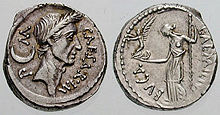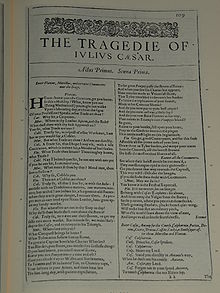- Cultural depictions of Julius Caesar
-
Gāius Jūlius Caesar (100 BC – 44 BC), one of the most influential men in world history, has frequently appeared in literary and artistic works since ancient times.
Contents
Ancient literary works
- Caesar is referred to in some of the poems of Catullus (ca. 84-54 BC)
- He is depicted in Virgil's Aeneid (ca. 29-19 BC), an epic poem about the foundation of Rome
- He appears as a character in Lucan's Pharsalia (AD 61), an epic poem based on Caesar's civil war
Medieval works
- A legendary account of Caesar's invasions of Britain appears in Geoffrey of Monmouth's Historia Regum Britanniae (ca. 1136)
- In the 13th century French romance Les Faits des Romains, Caesar is made a bishop
- In the 13th century French chanson de geste Huon of Bordeaux, the fairy king Oberon is the son of Caesar and Morgan le Fay
- Caesar appears in Canto IV of Dante Alighieri's epic poem The Divine Comedy (ca. 1308-1321). He is in the section of Limbo reserved for virtuous non-Christians, along with Aeneas, Homer, Ovid, Horace and Lucan. His assassins, Brutus and Cassius, and his lover, Cleopatra, are seen among the souls of the wicked in the lower regions of hell.
- Caesar was included as one of the Nine Worthies by Jacques de Longuyon in Voeux du Paon (1312). These were nine historical, scriptural, mythological or semi-legendary figures who, in the Middle Ages, were believed to personify the ideals of chivalry.
- Caesar's civil war and assassination are recounted in Geoffrey Chaucer's Monk's Tale (ca. 1385, one of his Canterbury Tales)
Renaissance and modern works
- Historia de omnibus gothorum sueonumque regibus ("History of all Kings of Goths and Swedes") by Johannes Magnus, the last functioning Catholic Archbishop in Sweden, and also a theologian, genealogist, and historian. Published in 1554. Caesar appears as a contemporary of the Swedish King Lindormus.
Theatre
- Pierre Corneille's The Death of Pompey (1642)
Opera
- Handel's Giulio Cesare (first performed 1724)
Statues
- Fountains in Olomouc: Fountain of Caesar in Olomouc (photo) (1725). It is based on the statue by Gian Lorenzo Bernini depicting Constantine I in Scala Regia (Vatican).
Modern works
Advertising
- Benetton's 1988 "United Superstars of Benetton" print and billborad campaign, paired with Leonardo da Vinci [1]
Theatre
Fiction
- Masters of Rome, a series of seven novels by the Australian writer, Colleen McCullough
- Tros of Samothrace, a historical novel by Talbot Mundy, has Julius Caesar as the novel's villain. Mundy depicts Caesar and Roman civilization as imperialist and tyrannical. When the novel was serialised in Adventure magazine in 1925-26, it sparked a controversy in the magazine over whether Caesar was a just ruler or a tyrant; one of the contributors to this debate was Elmer Davis.[2]
- Emperor Series, a series of four novels by the writer, Conn Iggulden
- Roma Sub Rosa, a series of historical mysteries by the American writer, Steven Saylor
- Ides of March is an epistolatory novel by Thornton Wilder dealing with characters and events leading to, and culminating in, the assassination of Julius Caesar.
- Sword of Caesar (1987), in the Time Machine series, asks the reader to travel back to ancient Rome and find the fate of Caesar's battle sword.
Film
- Played by Fritz Leiber, Sr. in Cleopatra (1917)
- Played by Claude Rains in Caesar and Cleopatra (adapted from Shaw's play, 1945)
- Played by Harold Tasker in Julius Caesar (adapted from Shakespeare's play, 1950)
- Played by Louis Calhern in Julius Caesar (adapted from Shakespeare's play, 1953)
- Played by John Gavin in Spartacus (1960)
- Played by Rex Harrison in Cleopatra (1963)
- Played by Kenneth Williams in Carry on Cleo (1964)
- Played by John Gielgud in Julius Caesar (adapted from Shakespeare's play, 1970)
- Played by Gottfried John in Asterix and Obelix vs Caesar (1999)
- Played by Klaus Maria Brandauer in Druids (2001)
- Played by Alain Chabat in Asterix & Obelix: Mission Cleopatra (2002)
- Played by Alain Delon in Asterix at the Olympic Games (2008)
TV
- Cleopatra (1999 film) played by Timothy Dalton
- Julius Caesar played by Jeremy Sisto
- Empire (2005 TV series), played by Colm Feore
- Rome (TV series) Gaius Julius Caesar, played by Ciarán Hinds
- Wayne and Shuster's comedy sketch Rinse the Blood off My Toga is a spoof of Shakespeare's Julius Caesar in the form of a Dragnet episode
- Xena: Warrior Princess highlighted Julius Caesar as a major antagonist, played by actor Karl Urban
- Histeria!, where Caesar's appearance is based on Frank Sinatra
- Internet sitcom Custer and Julius: Beyond 2000, played by Steve Anderson
See also: Julius Caesar (Character) imdb.com page
Radio
- In "The Histories of Pliny the Elder" - a 1958 episode of the British radio comedy "The Goon Show" parodying epic films - Caesar is portrayed by Peter Sellers as Hercules Grytpype-Thynne, with Moriarty as a centurion and sidekick.
- In the BBC Radio 4 series Caesar! (2003–2007) written by Mike Walker, David Troughton played Julius Caesar in "Meeting at Formiae", the first episode of Series One.
Comics
- A depiction of the Gallic War Commentaries of Caesar's, "De Bello Gallico" appeared in the now defunct "Classic Illustrated" comic series entitled "Caesar's Conquests" from the 1940s to the 1970s
- Asterix comics, written by René Goscinny and drawn by Albert Uderzo, include a fictionalized Julius Caesar (complete with roman nose) as a recurring character.
- Caesar appears in Neil Gaiman's Sandman #30, "August" (collected in The Sandman: Fables and Reflections)
Games
- Where in Time is Carmen Sandiego features Julius Caesar in one of its stages.
- Caesar is depicted as Akihiko Sanada's ultimate persona in Persona 3.
- Fallout: New Vegas depicts a dictator who patterns himself after the various Caesares, Julius in particular.
- Julius Caesar appears as the leader of the Roman Empire in the Civilization series of strategy games.
References
- ^ "Benetton Group: Evolution of Communication Strategy" scribd.com Accessed 21 February 2010
- ^ Talbot Mundy: Philosopher of Adventure: A Critical Biography by Brian Taves. McFarland, 2006 (p. 137-143)
Categories:- Cultural depictions of Julius Caesar
- Roman emperors in popular culture
Wikimedia Foundation. 2010.





